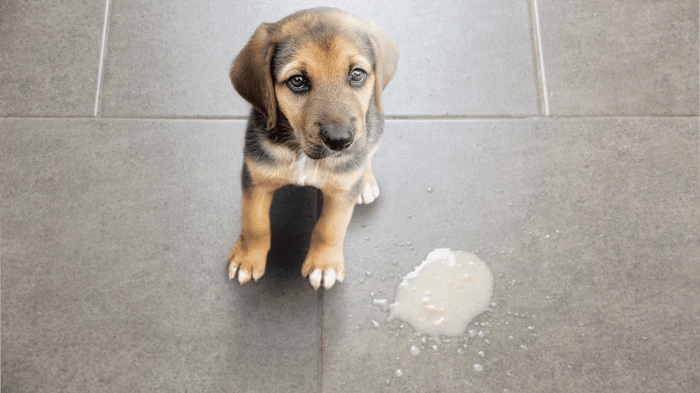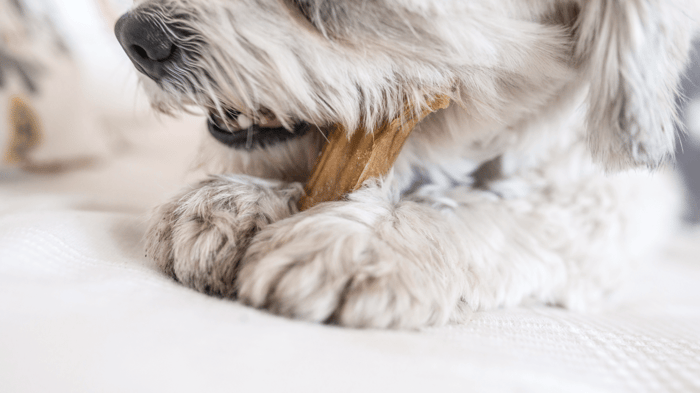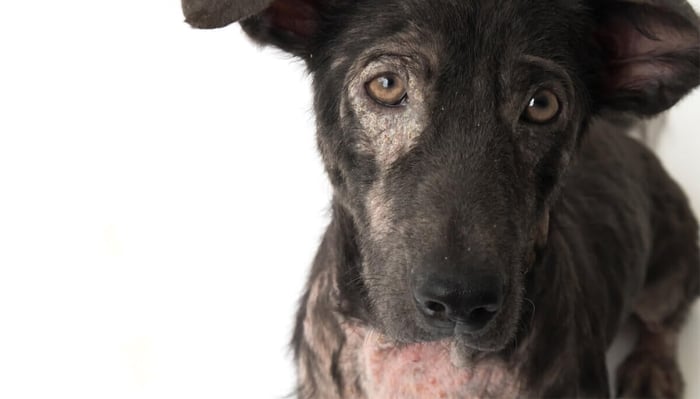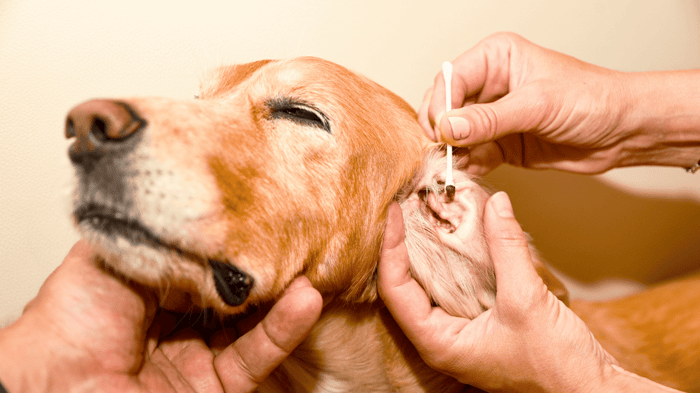All canines throw up from time to time, but when should you feed a dog after vomiting? Vomiting can happen for various reasons, including eating something that doesn’t agree with them, overeating, or illness.
Knowing when and what to feed your dog after throwing up may speed up recovery. You’ll need a handy odor eliminator to cope with the horrid puke smell if your dog throws up in the house. In the long term, you might want to introduce canine probiotics to your dog at your vet’s guidance.
We are grounding our advice on expert sources like Canine and Feline Gastroenterology, to keep you informed on canine vomiting. Read along to discover how to settle your dog’s restless and upset tummy.
So, when do you feed a dog after vomiting?
Feeding a dog immediately after vomiting is not recommended as it can cause further irritation to the stomach. It’s best to wait about 12 to 24 hours after vomiting before feeding food to allow their stomach to settle down. However, only withhold water for 2 to 6 hours since dehydration is a major risk when dogs vomit.
Vomiting is a forceful expulsion of food from your dog’s stomach. It is as uncomfortable for your dog as it is for you to watch. We have an even more complicated guide on canine throwing up in our article on what you should do if your dog vomits.
When it’s time to reintroduce food, it is crucial to start with small portions of easily digestible food such as boiled chicken (see our article on how to boil chicken for dogs) and rice. Gradually increase the amount and frequency of their meals over the next few days as their stomach returns to normal.
You also want to make sure anything you give your dog is very low in fat in case the vomiting is a sign of pancreatitis.
If the vomiting persists or your dog shows other symptoms, such as diarrhea or lethargy, it is best to consult a veterinarian.
If your dog vomits only once and seems otherwise healthy, you can offer him water after a few hours. If he keeps the water down, you can offer a bit of food. In this case, where vomiting is only mild and happens once, you may not even have to wait the whole 12 to 24 hours.
Sometimes, your veterinarian may recommend withholding food for a longer period, such as 24 to 48 hours. This is especially true if your dog has a gastrointestinal illness or has ingested something toxic. During this time, it is vital to ensure your dog has access to plenty of water to prevent dehydration.
You may also like:
Why is my dog throwing up after eating?
Why do dogs eat their own vomit?
Immediate Actions After Your Dog Vomits

When a dog vomits, it is essential to take immediate action to prevent further complications. Here are some recommended actions to take:
- Clean up vomit: Clean up the vomit immediately to prevent the spread of any harmful bacteria or viruses. Use gloves and disinfectant to clean the area thoroughly. You can also use a pet stain remover for deeper cleaning.
- Remove food and water: After vomiting, the dog’s stomach needs time to rest. Therefore, removing food and water for at least four hours is best to allow the stomach to settle. This will also prevent the dog from re-ingesting anything that may have caused the vomiting and upset stomach in the first place. Also see: How to deal with a dog’s upset stomach.
- Monitor your dog: Keep a close eye on your dog’s behavior after vomiting. If your dog is lethargic, has diarrhea, or shows any other signs of illness, it is important to seek veterinary attention immediately.
- Offer ice chips: If your dog is dehydrated after vomiting, you can offer ice chips to help hydrate them. This will also help to soothe their throat and stomach.
- Consider medication: If your dog has a history of vomiting or has been diagnosed with a medical condition that causes vomiting, give them medication as directed by your veterinarian. This can help to prevent further vomiting and alleviate any discomfort.
Remember, if your dog continues to vomit or shows any signs of illness, it is essential to seek veterinary attention immediately.
Feeding Your Dog After Vomiting
When a dog vomits, it can be concerning for pet owners. After vomiting, it is essential to be cautious when feeding your dog to prevent further complications. Here are some guidelines for feeding your dog after vomiting:
Initial Hours
During the first few hours after vomiting, it is recommended to withhold food and water to allow the stomach to settle. This gives the digestive system time to rest and recover. It is crucial to ensure the dog can access clean water to prevent dehydration. You can also take this time to observe if the vomit is due to ingesting toxins, with signs like foaming at the mouth.
First 24 Hours
After the initial hours, you can offer small amounts of water to the dog. If the dog can keep the water down for at least four hours, you can introduce small amounts of bland food. Bland food options include boiled chicken or rice. It is important to avoid feeding the dog any fatty or spicy foods during this time.
Please note that you should not withhold food for extremely tiny dogs like Malteses, Teacups, and Chihuahuas for this long. These dogs are susceptible to hypoglycemia, where the blood sugar levels get too low. Opt to take away their food for about 4 hours instead.
Beyond 24 Hours
If the dog can tolerate the bland food, the amount can gradually be increased over the next few days. It is crucial to monitor the dog’s behavior and appetite during this time. If the dog continues to vomit or shows signs of discomfort, it is recommended to seek veterinary care.
The Role of Hydration After a Dog Vomits
After a dog vomits, it’s essential to keep them hydrated. Vomiting can cause a loss of fluids and electrolytes, leading to dehydration. Dehydration can cause serious health problems, so it’s crucial to ensure your dog stays hydrated. Studies show that past a certain point, fluid therapy like IV is the only way to save dogs with severe dehydration from fluid loss.
Water is the best way to keep your dog hydrated. It’s essential to always provide your dog with fresh, clean water, but it’s imperative after vomiting. If your dog refuses to drink water, you can try to add a small amount of low-sodium chicken broth to their water bowl to make it more appealing.
In addition to water, you can also provide your dog with electrolyte solutions to help replace lost fluids and electrolytes. Many commercial electrolyte solutions are available for dogs, but you can also make your own by mixing water (1 liter), salt (1⁄2 teaspoon), and sugar (6 tablespoons) to make Pedialyte. However, it’s essential to consult with your veterinarian before giving your dog any homemade electrolyte solution.
Monitoring your dog’s urine output is essential to ensure they are properly hydrated. If your dog is not urinating or producing very little orange urine, they may be dehydrated, and you should contact your veterinarian immediately.
Monitoring Your Dog’s Health After Emesis (Vomiting)

After a dog vomits, it’s essential to monitor their health to ensure that they are recovering properly. Here are some things to keep in mind:
Observe Your Dog’s Behavior
Watch your dog for any changes in behavior. If they seem lethargic or lose appetite, it may be a sign that they are not feeling well. If your dog continues vomiting or diarrhea, it’s essential to seek veterinary care.
Related:
Check for Dehydration
Dehydration is a common side effect of vomiting. To check if your dog is dehydrated, gently pinch the skin on the back of their neck. If the skin does not quickly return to its normal position, your dog may be dehydrated. Other signs of dehydration include dry gums and sunken eyes.
How long can dogs go without water?
Offer Small Amounts of Water
It’s best to offer small amounts of water at a time. Giving your dog too much water too quickly can lead to further vomiting.
Gradually Introduce Food
After your dog has stopped vomiting, you can gradually introduce food into their diet. Start with small amounts of bland food, such as boiled chicken and rice. If your dog tolerates this food well, you can gradually introduce their regular diet into their meals.
You can start by giving them 25% of their normal food with the bland diet each time until it’s fully reintroduced.
By monitoring your dog’s health after vomiting, you can ensure they recover properly and avoid any potential health issues.
When to Consult a Vet For Dog Vomiting
While some cases of dog vomiting can be resolved at home, there are times when it’s essential to seek veterinary attention. Here are some situations where a vet visit is recommended:
Persistent Vomiting
If your dog has been vomiting repeatedly for more than 24 hours or more than thrice in 24 hours, it’s time to take them to the vet. This could indicate a more serious underlying condition, such as pancreatitis, kidney disease, or liver disease.
The vet will be able to conduct tests to determine the cause of the vomiting and provide appropriate treatment.
Blood in Vomit
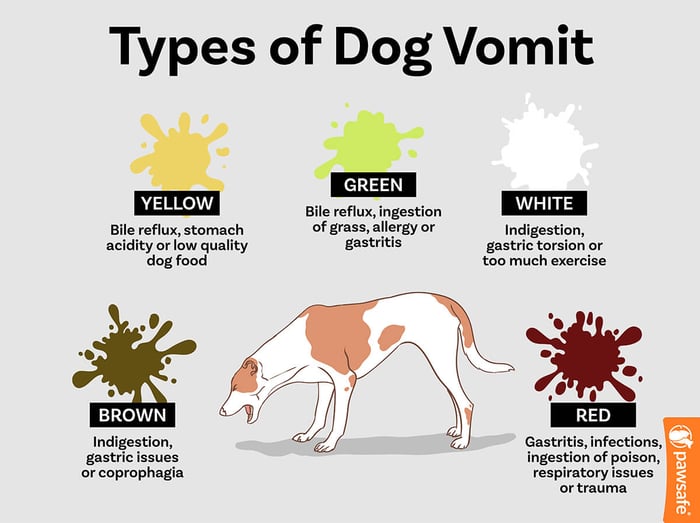
If your dog is vomiting blood, you must seek veterinary attention immediately. This could indicate a serious condition such as poisoning or gastrointestinal cancer. The vet will be able to determine the cause of the bleeding and provide appropriate treatment.
Other Symptoms
If your dog is experiencing other symptoms in addition to vomiting, such as red diarrhea, lethargy, or loss of appetite, it’s essential to consult a vet. These symptoms could indicate an underlying condition, such as pancreatitis or viral infections, that require medical attention.
In general, if you’re unsure whether your dog’s vomiting requires veterinary attention, it’s always best to err on the side of caution and seek advice from a professional.
Frequently Asked Questions (FAQs)
How long should I wait to feed my dog after vomiting?
What should I do if my dog is throwing up everything he eats and drinks?
Is it normal for my dog to sleep after vomiting?
How can I make my dog feel better after throwing up?
When should I be concerned about my dog vomiting?
Should I give my dog water after vomiting?
Final Thoughts
Feeding a dog after vomiting can be a tricky task, but it is important to ensure that the dog is getting the necessary nutrients to stay healthy. As discussed, it is recommended to wait for at least 12 to 24 hours after vomiting before feeding the dog. This will give the dog’s stomach enough time to settle down and reduce the risk of further vomiting.


